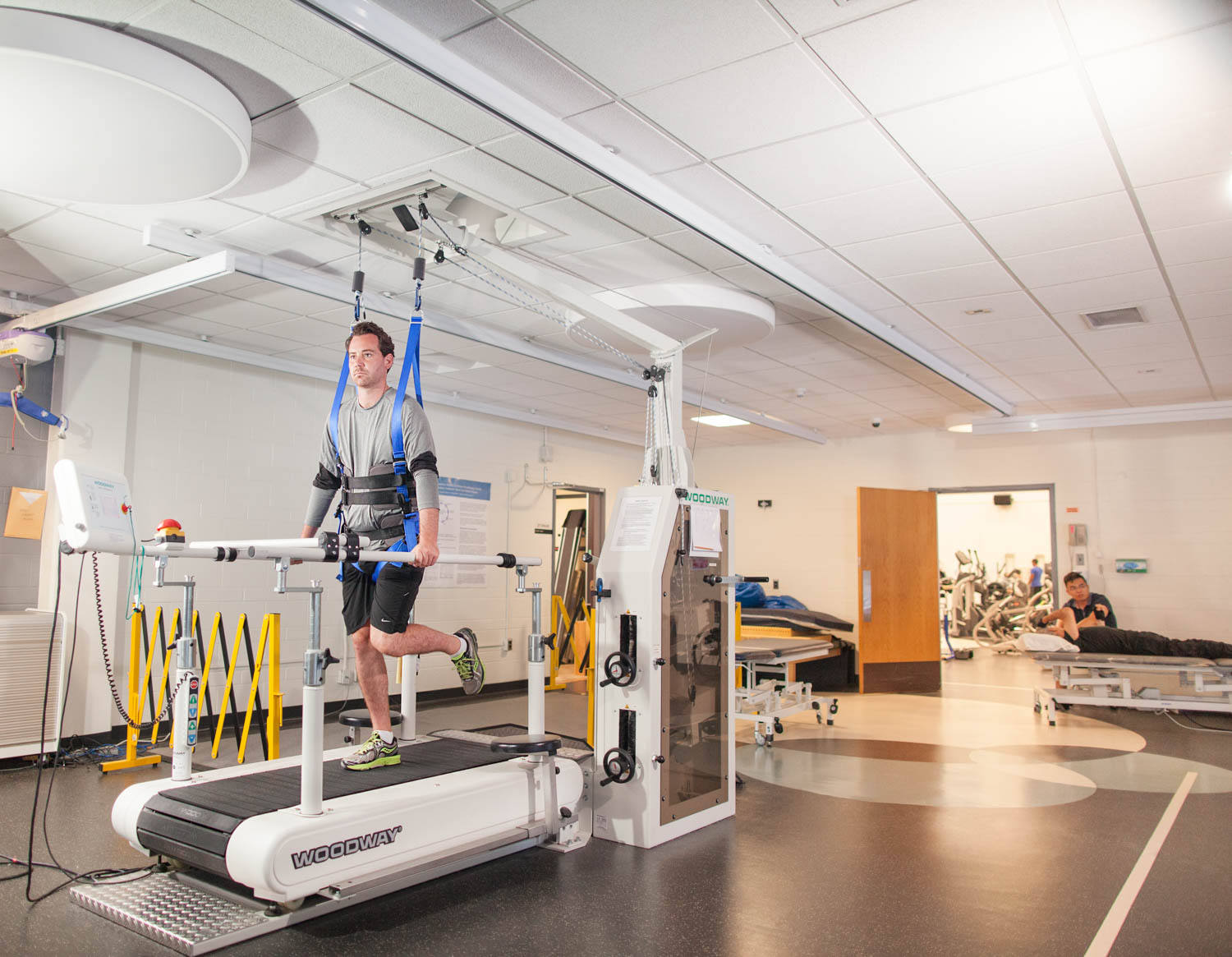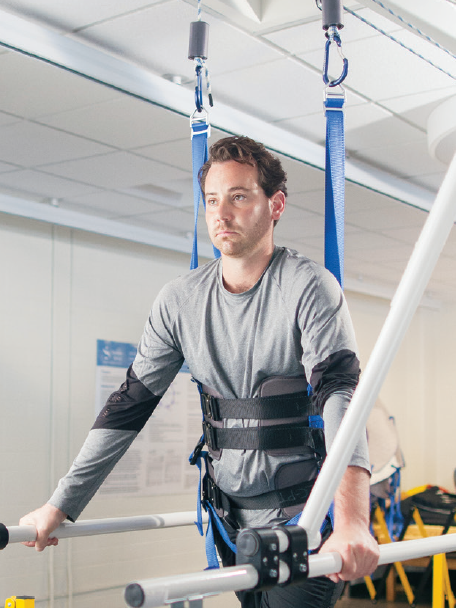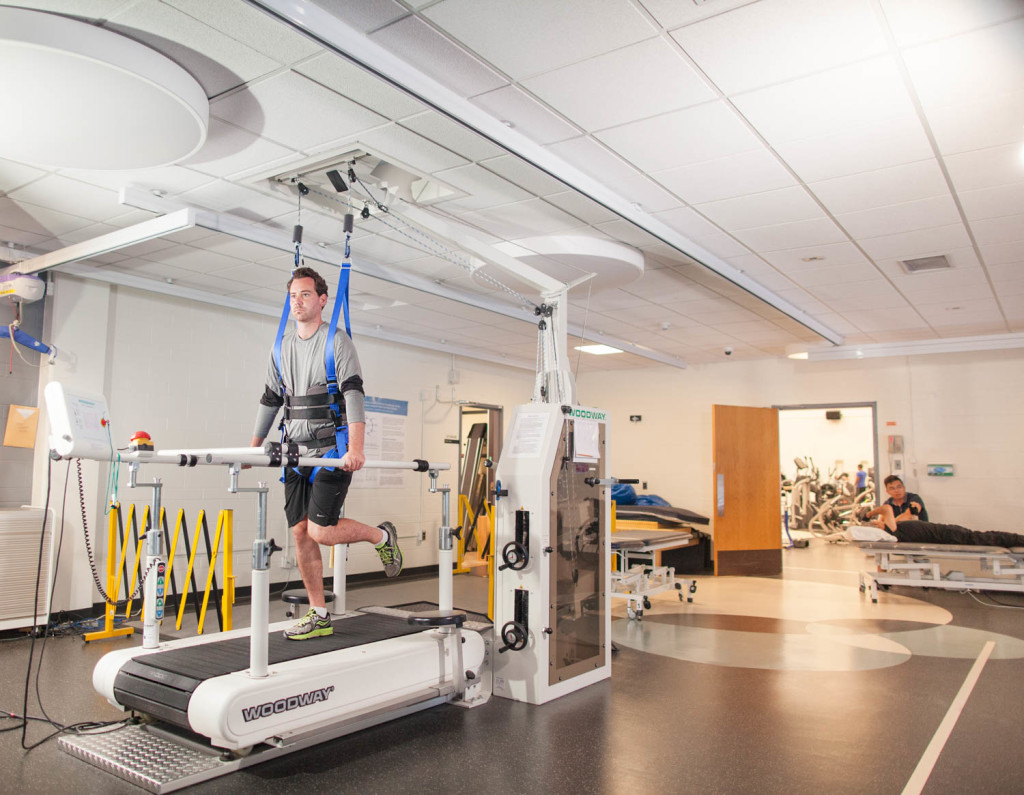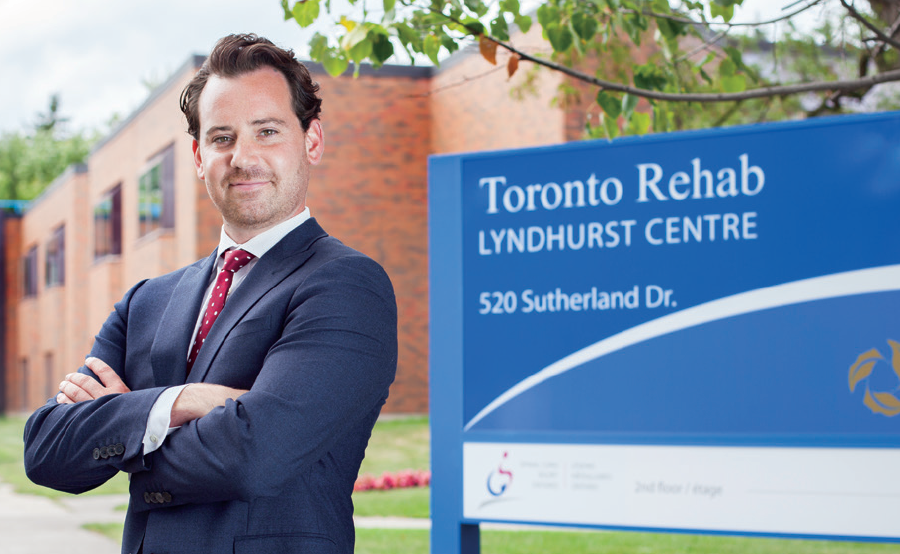I will: from learning how to walk again to running the marathon

With nine broken vertebrae, 11 broken ribs, a punctured lung and no sensation below his waist, doctors gave Robert MacDonald a five per cent chance of ever walking again. Three years later, he’s training for his first marathon.
When Robert MacDonald was two years old, he broke his leg and was put in a full cast. His elder sister remembers his voracious crawling. Three functioning limbs propelling him forward, with his motionless leg dragging behind.
Twenty-four years later in January 2013, MacDonald attempted a walking challenge of a different kind.
With mobility only in one leg, a walker propped him up. His physiotherapist supported him under one arm, while an assistant stood behind him grasping a wheelchair in case he fell. As MacDonald approached the six-minute mark, the assistant tightened her grip around the wheelchair’s handles.
Despite his right foot dragging and weighing him down, MacDonald grimaced with determination. He was using his upper body on the walker to get every last metre registered on a basic mobility test. His right foot may have been limp but his resilience muscle was firing.
A month earlier, MacDonald had fallen 30 feet and suffered a traumatic spinal injury in Mexico. With no sensation below his waist, he was rushed by air ambulance to emergency surgery in Toronto. This walking test represented MacDonald’s will to regain his mobility. He didn’t know it then, but after his surgery, doctors gave him just a five per cent chance of ever walking again.
An Active Upbringing
An active kid growing up in Mississauga, Ont., MacDonald and his two sisters played rep-level hockey. In his teens, Robert took a hit from behind that badly separated his shoulder. Things were never quite the same after that hit, but he soldiered on, often reaching a point in a game where he would grip his suddenly limp arm and casually reach over with his good arm and thrust the shoulder back into place.
At age 20, while he was away at university, MacDonald’s mother suffered brain trauma in a boating accident. Robert and his siblings joined his father at her bedside before she died. “The suddenness and not being able to say goodbye was difficult for us all, but adversity helps to build character,” says his father Ken MacDonald. “Robert has always, thankfully, chosen to deal with the deck that’s dealt, and move forward.”
MacDonald’s older sister Rebecca saw a big change in her brother in the months following their mother’s death. “I believe it was a realization for him that life can be short and unpredictable,” she says.
A Fateful Choice
MacDonald returned to school, where he earned his license as a real estate broker. In December 2012, he went to Cabo, Mexico with four friends for a vacation.
One night during the trip, his friend fell asleep in their shared room, leaving MacDonald locked out. MacDonald decided to enter the third-floor room through the balcony. The three storey climb looked attainable to the confident MacDonald, who says his decision was because of his ego and not alcohol.
“A large part of the injury is about accepting what your new life is going to be like. I wasn’t very good at that.”
He easily climbed two balconies, and was lifting himself up to the third when that shoulder from his hockey days dislocated. He lost his grip and fell 30 feet.
Landing on his side, MacDonald fractured nine vertebrae (T2 to T10), dislocated his spine in two places, broke 11 ribs and his scapula and punctured a lung. He was in shock but not concussed. As he lied there, he realized that he couldn’t feel or move his legs.
The first person to come to his side was an American paramedic, also on holiday, who checked MacDonald’s vital signs, and waited with him for the ambulance. At the Mexican hospital, the doctor determined MacDonald needed surgery but it could wait until the next day. MacDonald remembered the hospital staff who operated his CT scan watching a boxing match as he lay in the machine.
Meanwhile, MacDonald’s insurance company had reached out to Dr. Howard Ginsberg, a neurosurgeon with a PhD in biomedical engineering, who was on-call that night at Toronto’s St. Michael’s Hospital. Dr. Ginsberg determined that surgery was urgently needed. He quickly arranged MacDonald’s immediate air transfer back to Canada. MacDonald landed in Canada just over 24 hours after the fall.
Just Five Per Cent
“Nothing prepares a father for a call in the middle of the night when it’s from a young friend of your son who must  explain that your child has fallen from a building, and is paralyzed from the waist down,” says Ken MacDonald. “Robert was awake and wearing his typically stoic face the next day as his stretcher rolled past us into the emergency receiving area.”
explain that your child has fallen from a building, and is paralyzed from the waist down,” says Ken MacDonald. “Robert was awake and wearing his typically stoic face the next day as his stretcher rolled past us into the emergency receiving area.”
A team of surgeons and doctors assessed MacDonald and concluded the damaged vertebrae were pinching the spinal cord, blocking vital blood flow and preventing nerves from conducting electricity. The extent of the injury progressed the longer surgery was delayed.
The surgery used a 3D intra-operative scanner akin to having a GPS for spinal and brain operations. Once MacDonald’s spine was straightened, the scanner secured it with screws inside his body without opening up the back and exposing the spine. MacDonald was then placed in a room at the hospital to start the healing process. He still couldn’t feel or move his legs. What MacDonald didn’t know was that the team of doctors and surgeons who worked on him had already given him a diagnosis: asia B paraplegia. Typically, only about five per cent of these patients make full recovery, and 95 per cent never walk again.
He spent over four weeks resting and recuperating at St. Michael’s, all of them in a wheelchair. Eventually he started to feel touch in different parts of his legs.
In the first month of his recovery, MacDonald lost 35 lb., which was mostly muscle mass. As his ribs and vertebrae healed, he weaned off the morphine.
“I WILL”
His eyes were on recovery not acceptance, recalls his father. That played out in many ways. Once, MacDonald refused to cooperate with social workers after they introduced him to a young woman who had adjusted to life in a wheelchair. “A large part of the injury is about accepting what your new life is going to be like,” says MacDonald. “I wasn’t very good at that.”
Another time, MacDonald went to the whiteboard in his hospital room, and erased the daily weather report. In large capital letters he wrote, “I WILL.”
It was a phrase that came to MacDonald as he struggled in his wheelchair and relied on others for what were once basic tasks. “I will” was a promise to himself and a declaration to others that his current state was temporary. “I will” became his mantra.
His family and friends encouraged him with daily visits, positive notes, day trips outside the hospital and stories of
encouraging recoveries.
About three weeks into his hospital stay, MacDonald called his university friend Eric Humes. “You’ve got to get down to the hospital,” he screamed. “I have something to show you!” Once Humes arrived, MacDonald ordered him to move the blankets covering his legs and look at his toe. “I looked down to see his big toe moving ever so slightly,” says Humes.
MacDonald first noticed an involuntary movement in his toe seven days after surgery. Now, he could move it himself. Humes, overwhelmed by the discovery, proclaimed MacDonald was going to eventually walk again. Humes, a two-time Ironman, then went even further. “I said to Rob, ‘One day we will run a marathon.’” MacDonald was not entirely convinced about this prediction. Still, he agreed to the marathon pledge.
Over time, there were more muscle twitches, more subtle movement. Soon, MacDonald could lift a kneecap. Then his
left foot became more responsive.
The Miracle Man
At the beginning of January 2013, MacDonald moved from critical care at the hospital to recovery at Lyndhurst Spinal Cord Rehabilitation Centre. There he began an intensive physical and mental rehabilitation process – about four to five hours a day.
At one month in, MacDonald stood with aid for the first time. At two months, he walked with aid. At three months, he walked on his own for the first time.
MacDonald exceeded so many expectations, his surgeon Dr. Ginsberg started calling him the “Miracle Man.” “He breaks the mould of what people expect,” says Josh Williams, a physiotherapist at Lyndhurst. “That said, not everyone with an incomplete spinal cord injury recovers to the level that Robert did. He pushed his central nervous system to improve and as such it plastically adapted to the demands placed on it.”
Toward the end of MacDonald’s in-patient stay in March 2013, he was able to walk on his own and had completed an evaluation to return to driving. On MacDonald’s last day, Williams suggested they try hockey at a nearby rink. With his skates on the ice, the former hockey player stumbled like Bambi and fell spectacularly on his butt. “By the end he was skating around the rink, slowly, on his own,” says Williams. “I think it helped him see that he could return to activities that he once enjoyed.”
Stand, Skate, Walk, Run, Climb
Now back to living on his own and travelling to the centre for rehab, MacDonald and his sister Rebecca started training for a 10K that Easter. His limp was evident in every step. He fatigued easily. Every stride required intense focus. “It takes a lot of determination but also a bravery to let the body unlearn movement compensations,” says Darryl Tracy, MacDonald’s neuro-physiotherapist since October 2013. “Neurological rehabilitation is training at a complex and Olympic level.”
With a group of friends and family joining him, MacDonald walked the 2013 Mercedes 10k in Oakville. It took him over 90 minutes, but he refused to quit. The next year, he ran it. In 2015, his stride lengthened and his pace accelerated. With his growing progress, his ambitions also grew.
In 2014, he and a long-time friend climbed the Maderas mountain in Nicaragua – a one-day climb of 1,395 metres. In 2015, he camped in Newfoundland’s Gros Morne National Park and summited 805 metres.
Nearly three years after his injury, his “I WILL” needed additions. His next goal was to run the Scotiabank Toronto Waterfront Half-Marathon without stopping.
“To say that the competitiveness is completely out of me would be a lie,” laughs MacDonald. “But my approach and appreciation is different. When I used to run, it was about making my body go as fast as I could go. Now it’s more about getting out there and being free.”
21K – Don’t Stop, Won’t Stop
Humes and dozens of other friends committed to do the 21k with MacDonald in October 2015. Many of them were new to running and inspired by his journey. By race day, 72 runners were on the “I WILL” team, including both of MacDonald’s sisters. Teammates were asked to fundraise for the Lyndhurst Spinal Cord Rehabilitation Centre.
The notion of paying it forward is not lost on MacDonald, whose spine-correcting surgery was due in part to hospital
donors. MacDonald hopes his fundraising efforts will one day help someone like him. “It’s not for me,” he likes to say. “It’s for the next me.”
“When I used to run, it was about making my body go as fast as I could go. Now it’s more about getting out there and being free.”
By race day, his team raised over $73,500 for the rehab centre.
MacDonald’s family and many health-care providers cheered as MacDonald set out for the run of his life.
“I had a group of seven that ran every step of the race with me. About 25 people were by my side at different points in the race.” For the final kilometre, the “I Will” crew went into high gear with MacDonald going from a 6:42 km/h average pace to 5:08 km/h. MacDonald broke down for a moment after crossing the finish line. He says he was overcome with joy from the accomplishment and team effort.
Next Goal: A Marathon in 2016
True to form, MacDonald started to focus on his next goal when most race-day runners fixated on milkshakes or an Epsom salt soak, including running a marathon in 2016.
He’s also in discussions with the team at Red Bull to partake in The Wings for Life World Run on May 8, 2016, where 100 per cent of the race fees and proceeds go to research into finding a cure for spinal cord injury. This international race involves a “catcher car” driving at set speeds 30 minutes after the runners start. Once the car passes the runners, their distance is logged and their race is over. The global champions are the last man and woman worldwide to be passed.
An untraditional, adventurous, wild, fun and meaningful race? It has MacDonald’s name written all over it.
Tania Haas is a regular contributor to Canadian Running. Read her interactive feature about the 35th anniversary of Terry Fox’s Marathon of Hope here.




